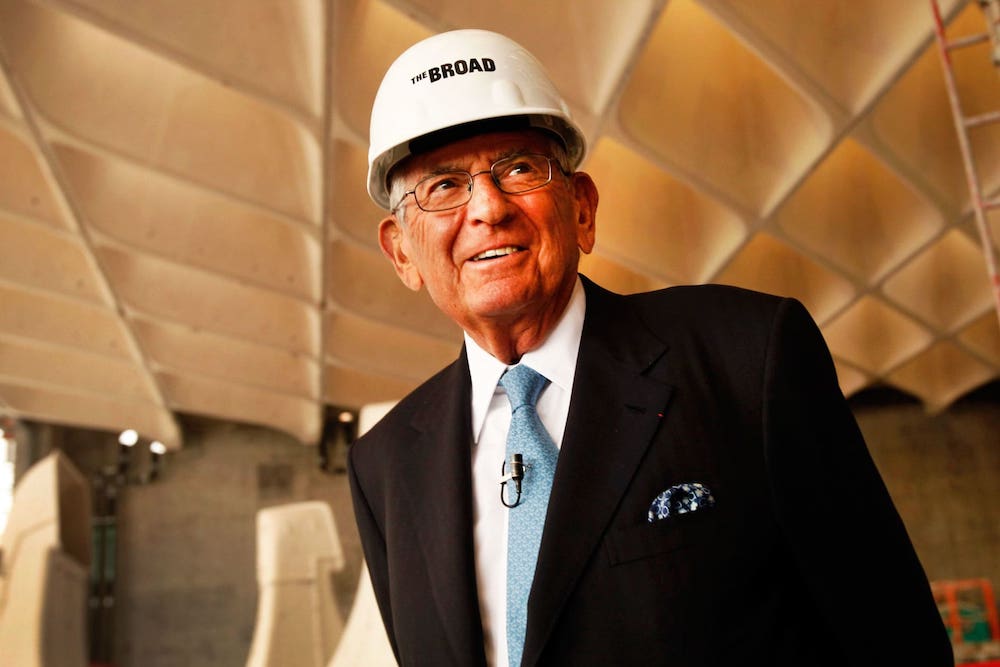Your cart is currently empty!
The Art World After ELI BROAD Art Brief

Billionaire Eli Broad, who passed away in April at 87, was a giant of philanthropy not just in the art world but also in education, medicine and science. He was among the top handful of cultural benefactors in Los Angeles history—his footprint includes Disney Hall, the Grand Avenue redevelopment project, MOCA, The Broad museum, BCAM at LACMA, the Broad Art Center at UCLA and the Broad Stage at Santa Monica Community College.
Broad was the rare businessman who made two fortunes, one in real estate with Kaufman & Broad and the other with Sun America—an insurance giant. However, his true passions in life were art collecting and philanthropy.
He was universally described as difficult to deal with—to put it mildly. He began a long feud with starchitect Frank Gehry who he replaced because “he took too long” to build the Broads’ landmark Brentwood home (completed with Gehry’s design intact) and dueled with him over the bumpy construction timeline of Gehry-designed Disney Hall.

Broad was the principal founding patron of MOCA, helping to fund and negotiating the acquisition of the 80-piece Panza Collection (including multiple masterpieces by Rothko and Rauschenberg) at what was, even in the ‘80s, an $11 million steal. He was instrumental in bailing out MOCA when it faced insolvency in 2008.
He was criticized for engineering the 2010 hiring of a renowned art dealer, Jeffrey Deitch, as MOCA’s director (Deitch, who had a controversial tenure and got a bum rap when he was terminated, has made a spectacular return to LA with cutting-edge museum-quality shows at his gallery in Hancock Park). Broad also had a hand in the dismissal of MOCA’s highly regarded longtime curator Paul Schimmel—who did not get along with Deitch.
For years Broad kept the art world buzzing about what he would do with the Broad Foundation’s billion-dollar collection of 2,000-plus works by blue-chip artists that spanned the decades from the ‘60s when he and his wife Edye began collecting. The foundation’s collection was stored in a warehouse—those with connections secured a visit, though it was also open for school tours. LACMA seemed to be the ultimate beneficiary, especially when the Broad Contemporary Art Museum (BCAM) building went up on the LACMA campus financed with $60 million of Broad funds.
But Broad—“a control freak” according to Gehry— ultimately decided to build an eponymous museum adjacent to Disney Hall on Grand Avenue and across from MOCA to house the collection. The Broad museum was an instant success, with attendance quickly dwarfing MOCA’s primarily because admission was free. MOCA was soon forced to match that policy.
The Broads have been criticized for playing it safe—their New York-centric collection is heavily weighted with cornerstone contemporary artists including Johns, Rauschenberg, Lichtenstein, Twombly and Warhol, and with top artists from the Gagosian Gallery such as Koons, Hirst and Murakami. The paucity of California artists (except for Baldessari and
Ruscha) and works by light and space artists are glaring omissions.

Who can replace Broad as the patron saint of California philanthropy? Probably no one. However, it’s important to note that the Broads were true partners in the art world and that Edye Broad played a major, if not decisive, role in writing the checks. As a leader of the Broad foundation, she will undoubtedly keep a sharp eye on the direction of grant-making.
At the top of the list of benefactors who could step in is billionaire entertainment mogul David Geffen—a major donor to such LA art institutions as the Geffen Playhouse in Westwood. Geffen made a $150-million gift to LACMA for construction of the new Peter Zumthor—designed building, whose galleries will bear his name.
The bull stock market of the last year has increased the fortunes of young tech titans, but they have been perennially disappointing when the time comes to actually pony up, with the exception of the not-so-young George Lucas, whose billion-dollar Lucas Museum of Narrative Art is scheduled to open in Exposition Park in two years.
The last time I talked with Broad was at a LACMA luncheon honoring Frank Gehry on the occasion of his retrospective. Even though they feuded, Broad was there to show his support—a class act. Eli Broad was a truly inimitable figure who has stamped his imprint on the City of Angels for the ages.
[/et_pb_text][/et_pb_column][/et_pb_row][/et_pb_section]